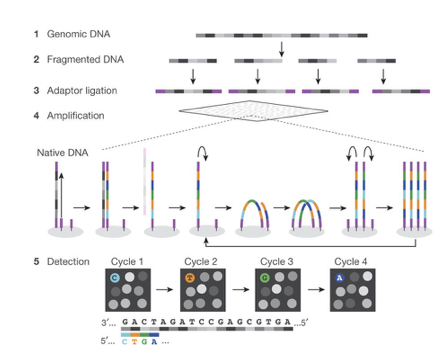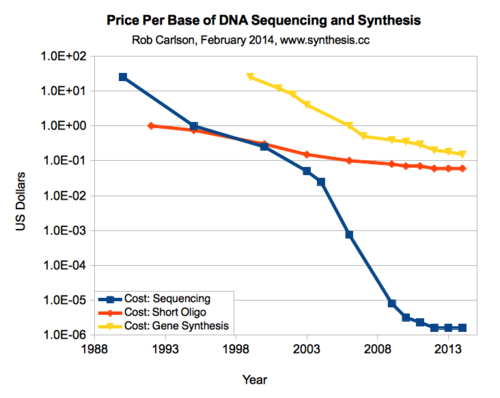Week 5 Preclass - Evolution
DNA Reading & Writing
Preclass for Monday
Please read and consider the below before start of class on Monday. The questions given are only study questions not homework to be graded. Talk about it all with your classmates, friends, or TAs, as you like.
Introduction - DNA read and write past, present, and future
This week we will explore What changes may arise via trends in DNA read and write tools may matter for the rest of our lives? We hope you will learn more about the core capacities for accessing and encoding DNA and also consider the quantitative pacing of how these tools are improving. Monday’s pre-class material focuses mostly on DNA sequencing, whereas Wednesday’s pre-class material focuses on DNA synthesis…
Goal 1: You should be able to describe how DNA sequencing works.
Goal 2: You should be able to describe the pace of developments in DNA read and write and be ready to discuss the ramifications of this development.
Goal 3: You should also be able to describe how DNA synthesis works.
Goal 4: You should gain a capacity to strategically evaluate quantitative trends and qualitative transitions.
Let’s begin!
DNA literacy – DNA read
DNA is made up of nucleotides. These nucleotides have four possible bases; adenine (A), thymine (T),guanine (G), and cytosine (C). All DNA is made up of sequences of these four bases. Imagine a four key typewriter that is able to type the DNA codes for all of the biodiversity seen on earth. Being able to both read DNA (sequencing) and write DNA (synthesizing) has and will continue to give bioengineers the ability to design and build with living matter in ways that were hard to imagine very recently.
Let’s delve into how current sequencing technologies work.
Start with this video that provides background about sequencing and its use to decode the human genome, with a focus on “massively parallel sequencing” (often marketed as “next-generation” sequencing technology). Figure-2, also breaks down the same process described in the video.

Figure.2. “Breakdown of DNA sequencing steps (specifically next generationsequencing). In this approach instead of reading a long sequence of DNA one baseper at a time, the sequence is divided into many pieces (fragments) which are all read simultaneously”. Source
During sequencing first, the genomic DNA (the DNA that we want to read) is broken into smaller pieces (fragmented). Then a synthetic linker sequence is added to the end ofthe fragments (adaptor) which helps the DNA fragments get attached to a surface on which the sequencing happens (flow cell). Next, the DNA fragments are separated inspace and read individually. Each fragment is amplified (thousands of copies of eachpiece is made) to make sure the correct sequence is detected. To actually read the fragments, pre-labeled nucleotides (nucleotides with color) and enzymes (that incorporate nucleotides into the fragments) are added to the flow cell. As each colored base pair is added to the fragments a new colorful spot is introduced. By taking images from the spots we are able to decode the sequence. Finally, the fragments are stitched together to reveal the original sequence of the genomic DNA. Here is an additional video that describes this process in even more detail optional link.
Optional reading-1: DNA sequencing at 40: past, present and future.
Q.1. According to the “How to sequence the human genome” video when was the first human genome sequenced? How long did it take? How much did it cost?
Q.2. How much would it cost if you were to sequence the human genome in 2018?
Q.3. Thinking back to the design, build, and test (DBT) class. What are theconsequences of lowering sequencing cost (both money and time)?
DNA literacy – DNA write
- A less than 4 minute video introducing how Agilent builds 60mer oligos using inkjet dispensing. link
Q.4. How is inkjet printing used to write DNA?
- A summary of existing and recent DNA synthesis companies: link
*Optional reading-2: Synthetic DNA Synthesis and Assembly
Extra learning:
Advanced learning-1: Next Generation Sequencing video lectures By Eric Chow
Advanced learning-2: Genome Sequencing for Pathogen Discovery video lectures Joe DeRisi
An article on difference approaches to DNA synthesis: link
Image Sources:
- Next-Generation Sequencing: Shendure et al, Nature 2017 link
Preclass for Wednesday
Please read and consider the below before start of class on Wednesday
On Monday, we discussed the technology and science behind DNA sequencing and synthesis. Today’s reading addresses the quantitative and qualitative pace of change and the consequences arising from these changes.
Example 1: DNA trends: Non-invasive prenatal testing
Put yourself in the shoes of a couple who recently discovered they were pregnant, and are worried about genetic disorders in their unborn child (e.g., Down syndrome).
Scenario-1: It is 2010 and the standard of care is amniocentesis, an invasive procedurein which a large needle is used to directly sample fluid from the amniotic sac optional link
Q.1. What do you think about the test, would you take it? Why?
Scenario-2: It is 2020 and in leading-edge children’s hospitals amniocentesis has been replaced by non-invasive prenatal testing (NIPT), previously known as cell free DNA testing. NIPT is based on a simple blood draw that enables determination of geneticdisorders and even the sex of an unborn fetus. The test works because it turns out that there is DNA from the fetus circulating in the pregnant woman’s blood (e.g., if a pregnant woman has Y chromosome DNA in her blood then she is carrying a malefetus). Please watch video about cell free fetal DNA analysis if you want moredetail.

Figure.1. “Reduction of the Price of DNA sequencing and synthesis per base per over past 30 years. Source
Q.2. Do you think NIPT could have been economically feasible in the year 2010? What about 2000, or 1990? Why?
Q.3. What factors do you think led to exponential cost reduction in DNA sequencing?
Humans as individual biological organisms have historically been defined, literally, by a natural reproductive process in which the genetic material of our parents leads to us as individuals, and so on. Increasingly it is becoming apparent that we can assert our intention into the human reproductive process. E.g., about 4% of humans born in the US today arise and arrive via in-vitro fertilization. At the on-campus children’s hospital it is now standard practice for the DNA of the fetus to be partially sequenced at 10 weeks post-fertilization in order to screen for various genetic conditions, and this information is used to inform health decisions. Others are now beginning to apply advanced genetic engineering tools to edit genes within viable human embryos - see here for example link
Next, let’s consider what happens when information and material become interconvertible.
(Interconversion - a process in which two things are each converted into the other)
Not long ago, to listen to music, you had to have the musicians manipulating the air to make sounds. With the invention of recording, sound could be turned into information and stored in various physical objects (vinyl records, wires, cassette tapes, CDs,…). Given access to the object and a player, you could listen to music. Also, note that each medium quantitatively could store more information. However, with the introduction of the internet, there was an additional qualitative change. Now music could be shared as information via the network and played (or reconstructed into a physical object CD).
Similar interconversion is now possible for living matter. With the progress of DNA sequencing and synthesis, now it is possible to read the genome of a given cell in one location-A (Palo Alto), store, and transfer the DNA information to location-B (Boston). Then DNA information can be resynthesized into a physical object (DNA polymer) from scratch.
Interconversion of DNA information into physical DNA can also be used to read the genome of animals, cells, or viruses that have been extinct and reconstruct them from scratch.
Next consider the following example:
This link provides the full genome of the 1918 flu that infected up to one third of the world population a century ago: Flu genome sequenced.
Q.4.Should the sequence of the virus be available online?
Q.5.Who should have access to tools (DNA read and write) for engineering living matter? How (or should) it be controlled?
Image Sources:
- Carlson Curves link
Preclass Reading for Friday
Task: As a team attempt a brainstorm and bring at least one idea per person to class on Friday.
github source code for teaching staff